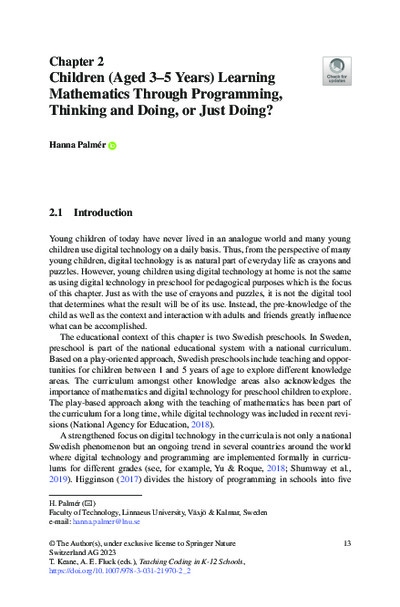Children (Aged 3–5 Years) Learning Mathematics Through Programming, Thinking and Doing, or Just Doing?Hanna Palmér
|
 |
 Diese Seite wurde seit 2 Jahren inhaltlich nicht mehr aktualisiert.
Unter Umständen ist sie nicht mehr aktuell.
Diese Seite wurde seit 2 Jahren inhaltlich nicht mehr aktualisiert.
Unter Umständen ist sie nicht mehr aktuell.
 Zusammenfassungen
Zusammenfassungen
 In this chapter, a Swedish development and research project integrating programming and mathematics will be focused on. The children in the project were 3–5 years old. Preschool children together with their teachers worked with programmable robots especially designed for young children. Several programming activities were developed and introduced in four rounds. Common in all these activities was the children investigating programming and mathematics by trying them out themselves. The results show that the children developed their spatial thinking and their understanding of symbols. Also, they developed their ability to use notions such as ‘forward’, ‘backward’, ‘rotate’ and ‘turn’, verbally through symbols and gestures.
In this chapter, a Swedish development and research project integrating programming and mathematics will be focused on. The children in the project were 3–5 years old. Preschool children together with their teachers worked with programmable robots especially designed for young children. Several programming activities were developed and introduced in four rounds. Common in all these activities was the children investigating programming and mathematics by trying them out themselves. The results show that the children developed their spatial thinking and their understanding of symbols. Also, they developed their ability to use notions such as ‘forward’, ‘backward’, ‘rotate’ and ‘turn’, verbally through symbols and gestures. Dieses Kapitel erwähnt ...
Dieses Kapitel erwähnt ...
 Begriffe KB IB clear |  Kinder Kinder children
, children
,  LehrerIn LehrerIn teacher
, teacher
,  Lernen Lernen learning
, learning
,  Mathematik Mathematik mathematics
, mathematics
,  Programmieren Programmieren programming
, Programmieren für KinderProgramming for kids
, programming
, Programmieren für KinderProgramming for kids
,  Schule Schule school school
|
 Dieses Kapitel erwähnt vermutlich nicht ...
Dieses Kapitel erwähnt vermutlich nicht ... 
 Nicht erwähnte Begriffe | Bildung, Digitalisierung, Eltern, Primarschule (1-6) / Grundschule (1-4), Schweiz, Unterricht |
 Tagcloud
Tagcloud
 Anderswo finden
Anderswo finden
 Volltext dieses Dokuments
Volltext dieses Dokuments
 |  Children (Aged 3–5 Years) Learning Mathematics Through Programming, Thinking and Doing, or Just Doing?: Artikel als Volltext @ Springer ( Children (Aged 3–5 Years) Learning Mathematics Through Programming, Thinking and Doing, or Just Doing?: Artikel als Volltext @ Springer ( : :  , 307 kByte; , 307 kByte;  : :  ) ) |
 Anderswo suchen
Anderswo suchen 
 Beat und dieses Kapitel
Beat und dieses Kapitel
Beat hat Dieses Kapitel während seiner Zeit am Institut für Medien und Schule (IMS) ins Biblionetz aufgenommen. Er hat Dieses Kapitel einmalig erfasst und bisher nicht mehr bearbeitet. Beat besitzt kein physisches, aber ein digitales Exemplar. Eine digitale Version ist auf dem Internet verfügbar (s.o.). Aufgrund der wenigen Einträge im Biblionetz scheint er es nicht wirklich gelesen zu haben. Es gibt bisher auch nur wenige Objekte im Biblionetz, die dieses Werk zitieren.










 Biblionetz-History
Biblionetz-History